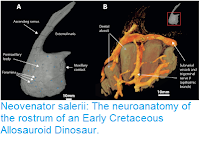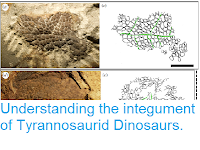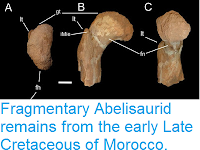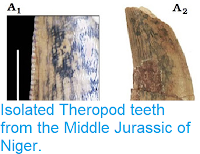The Kem Kem Beds of southeastern Morocco and neighbouring areas of Algeria are noted for the production of numerous Late Cretaceous Vertebrate fossils, including Fish, Crocodylomorphs, Turtles, and Dinosaurs, particularly large Theropods. These fossils appear to have come from a wide range of environments, and are poorly sorted stratigraphically (i.e. not arranged in time related order), and are generally thought to be the result of geological mixing.
In a paper published in the journal PeerJ on 30 May 2018, Simone Maganuco and Cristiano Dal Sasso of the Museo di Storia Naturale di Milano describe a pedal ungual (toe claw) from the Kem Kem Beds, which they interpret as having come from a juvenile Spinosaur.
Spinosaurs were exceptionally large Theropod Dinosaurs (the biggest species, Spinosaurus aegyptiacus is thought to have exceeded Tyrannosaurus, Giganotosaurus and Carcharodontosaurus in size, reaching about 11 m in length) with a distinctive morphology, including a long, Crocodile-like snout and a sail on the lower back and tail. The Spinosaurs are divided into
two groups, the Baryonychines from Laurasia (North America, Europe and Asia)
and the Spinosaurines in Gondwana (Africa, South America, India, Madagascar,
Antarctica, Australia and New Zealand, though the group is not known from all
these areas). However while the closely related Megalosaurs are well
established in the Middle Jurassic, almost all known Spinosaur specimens come
from the Cretaceous, making the origins of the group somewhat obscure.
The specimen described by Maganuco and Dal Sasso is a 18.2 mm in length, though it is thought to have lost about 2 mm from its tip, and closely resembles the pedal ungual of Spinosaurus aegyptiacus, with a flattened profile, a slightly convex upper surface and a porous structure. The specimen is, of course considerably smaller than the pedal ungual of Spinosaurus aegyptiacus, with the holotype for this species (i.e. specimen from which the species was named) having toe claws between 87 and 130 mm in length, however Spinosaurs were Tetanurans, a group which is thought to have changed little in morphology as they grew and developed, and isolated uguals of intermediate size have been referred to the genus Spinosaurus on this basis. Maganuco and Dal Sasso suggest that if the proportions did remain constant in life, then this specimen would have come from a Spinosaur about 1.78 m in length, the smallest known member of the group.
Pedal ungual phalanx of Spinosaurus. Specimen MSNM V6894 in right lateral (A), left lateral (B), dorsal (C), plantar (D), proximal (E), and distal (F) views. Abbreviations: as, articular surface; co, cortex; et, extensor tubercle; sb, spongy bone; vf, vascular furrow. Scale bar equals 5 mm. Michele Zilioli in Maganuco & Dal Sasso (2018).
See also...
Follow
Sciency Thoughts on Facebook.







